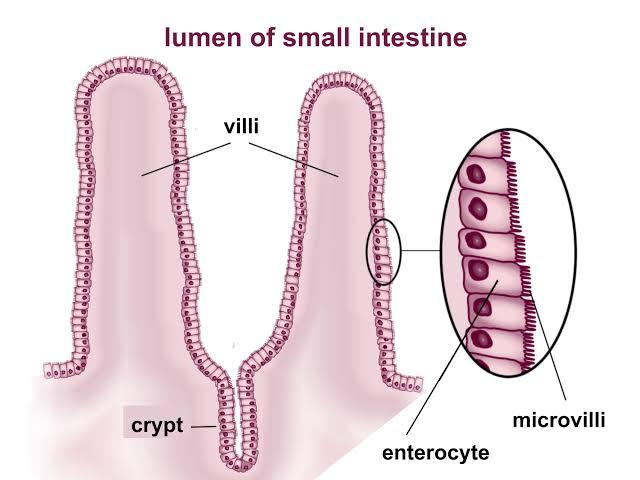
What are villi? What is their location and function?
Answer
516.9k+ views
Hint: The main function of villi is to increase the surface area of the membrane so that more food can be absorbed.
Complete answer:
Villi are tiny, vascular projections on the inner wall of the small intestine, which increase the surface area of the inner membrane and help in absorbing nutrients from the food that we eat and then transfer those nutrients to the bloodstream so that they can reach where they are needed.
Location: Millions of villi are located on the inner wall of the small intestine. These are also found on the membrane of the placenta.
Function:
- The inner wall of the small intestine is folded into finger-like structures, villi. Villi has many hair-like structures, called microvilli. Both villi and microvilli expand to increase the surface area of the inner membrane of the small intestine, so that more amount of digested food can be absorbed.
- These tiny projections absorb the protein molecules easily and help in transfer of them to all body cells and tissues.
-Each villus contains one artery and one vein in them. Having many blood vessels helps them in the absorption of digested food and these digested foods or nutrients can easily be carried by the bloodstream. Thus, the absorbed food reaches to each and every cell of the body.
- These villi move in swaying, contracting motions. This feature helps to increase the blood flow and lymph and enhances absorption.
Note: In singular form, the villi are called villus. Microvilli are found only on the inner membrane of the small intestine.

Fig: T.S. of small intestine showing villi and microvilli
Complete answer:
Villi are tiny, vascular projections on the inner wall of the small intestine, which increase the surface area of the inner membrane and help in absorbing nutrients from the food that we eat and then transfer those nutrients to the bloodstream so that they can reach where they are needed.
Location: Millions of villi are located on the inner wall of the small intestine. These are also found on the membrane of the placenta.
Function:
- The inner wall of the small intestine is folded into finger-like structures, villi. Villi has many hair-like structures, called microvilli. Both villi and microvilli expand to increase the surface area of the inner membrane of the small intestine, so that more amount of digested food can be absorbed.
- These tiny projections absorb the protein molecules easily and help in transfer of them to all body cells and tissues.
-Each villus contains one artery and one vein in them. Having many blood vessels helps them in the absorption of digested food and these digested foods or nutrients can easily be carried by the bloodstream. Thus, the absorbed food reaches to each and every cell of the body.
- These villi move in swaying, contracting motions. This feature helps to increase the blood flow and lymph and enhances absorption.
Note: In singular form, the villi are called villus. Microvilli are found only on the inner membrane of the small intestine.

Fig: T.S. of small intestine showing villi and microvilli
Recently Updated Pages
Master Class 11 Economics: Engaging Questions & Answers for Success

Master Class 11 Business Studies: Engaging Questions & Answers for Success

Master Class 11 Accountancy: Engaging Questions & Answers for Success

Master Class 11 English: Engaging Questions & Answers for Success

Master Class 11 Computer Science: Engaging Questions & Answers for Success

Master Class 11 Maths: Engaging Questions & Answers for Success

Trending doubts
State and prove Bernoullis theorem class 11 physics CBSE

1 ton equals to A 100 kg B 1000 kg C 10 kg D 10000 class 11 physics CBSE

State the laws of reflection of light

One Metric ton is equal to kg A 10000 B 1000 C 100 class 11 physics CBSE

1 Quintal is equal to a 110 kg b 10 kg c 100kg d 1000 class 11 physics CBSE

Difference Between Prokaryotic Cells and Eukaryotic Cells




